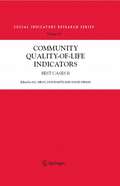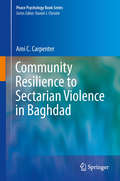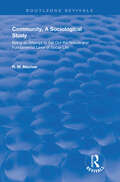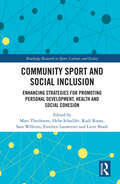- Table View
- List View
Community Quality-of-Life Indicators: Best Cases II (Social Indicators Research Series #28)
by David Swain M. Joseph Sirgy Don RahtzThis book is the second in a series covering best practices in community quality-of-life (QOL) indicators. The first volume is a compilation of cases of best work in community indicators research. This volume builds on the goal of the series and includes eleven cases describing communities that have launched their own community indicators programs. Elements included are the history of the community indicators work within the target region, and the planning of community indicators.
Community Quality-of-Life Indicators: Best Cases III (Community Quality-of-Life Indicators #1)
by M. Joseph Sirgy Rhonda Phillips Don RahtzCommunity quality-of-life (QOL) indicators continue to gain attention and interest in their use as many communities and regions design and apply them. Evolving from early use as data systems, indicators are increasingly being integrated into overall planning and other public policy activities. Their use is found not only in monitoring and evaluation applications, but also in the context of increasing citizen partici- tion in guiding communities towards achieving desired goals. Indeed, the emphasis in many indicator applications now includes linking actions to outcomes – making sure that the indicators are integrated, useful and effective in helping communities address QOL issues. The use of QOL indicators to consider a full spectrum of c- munity and regional well-being is exciting and the focus on integration is certain to bring new and innovative applications to the forefront. This is the third book in a series covering best practices in community QOL indicators. Each volume presents individual cases (chapters) of communities at the local or regional levels that have designed and implemented community indicators programs. In Volume I, we present eight chapters from a variety of contexts – from the county level in the U. S. , to the large megalopolis of Sao Paulo, to looking at a cross section of communities throughout Europe. Also included are three chapters from Canada, a leader in applying community indicator systems.
Community Quality-of-Life Indicators: Best Cases IV (Community Quality-of-Life Indicators #2)
by Don Rahtz M. Joseph Sirgy Rhonda PhillipsCommunity indicators projects are plentiful. These projects capture the quality of life in towns, cities, counties, metropolitan regions, and larger geographic regions. Community quality-of-life (QOL) indicators are increasingly being integrated into overallplanningandotherpublicpolicyactivities.Thecommunityindicatorsproject reports are used not only in monitoring and evaluation applications but also in the context of increasing citizen participation in guiding communities towards achieving desired goals. This is the fourth book in a series covering best practices in community QOL indicators. Each volume presents individual cases (chapters) of communities at the local or regional levels that have designed and implemented community indi- tors programs. In Volume IV, we present nine chapters from a variety of contexts: cities such as the City of Phoenix (Arizona, USA), Jacksonville (Florida, USA), and Bristol (UK), suburban communities areas such as Long Island (New York, USA) and Sydney (Australia), larger regions such as Vancouver (Canada), and townships such as Sobantu (South Africa).
Community Quality-of-Life Indicators: Best Cases V (Community Quality-of-Life Indicators #3)
by M. Joseph Sirgy, Rhonda Phillips and D. RahtzThe proposed book is a sequel to volume 1-4 of Community Quality-of-Life Indicators: Best Cases. The first volume, Community Quality-of-Life Indicators: Best Cases was edited by M. Joseph Sirgy, Don Rahtz, and Dong-Jin Lee and published in 2004 by Kluwer Academic Publishers in the Social Indicators Research Book Series (volume 22). The second volume, Community Quality-of-Life Indicators: Best Cases II was edited by M. Joseph Sirgy, Don Rahtz, and David Swain and published in published in 2006 by Springer in the Social Indicators Research Book Series (volume 28). The third and fourth volumes, Community Quality-of-Life Indicators: Best Cases III and Community Quality-of-Life Indicators: Best Cases IV, were edited also by M. Joseph Sirgy, Rhonda Phillips, and Don Rahtz and published in 2009 by Springer in the ISQOLS Community Quality-of-Life Indicators Best Cases Book Series (volumes 1 and 2).
Community Quality-of-Life Indicators: Best Cases VI (Community Quality-of-Life Indicators #4)
by M. Joseph Sirgy, Rhonda Phillips and Don RahtzThis book is the sixth in a series covering bet practices in community quality-of-life (QOL) indicators. The cases in this volume describe communities that have launched their own community indicators programs. Elements that are included in the descriptions are the history of the community indicators work within the target region, the planning of community indicators, the actual indicators that were selected, the data collection process, the reporting of the results, and the use of the indicators to guide community development decisions and public policy.
Community Rehabilitation Services for People with Disabilities
by Orv C. Karan Stephen GreenspanCommunity Rehabilitation Services for People with Disabilities delves into the changes happening in the disability services in the United States. The book focuses on how these changes are affecting the way professionals and agencies relate to people with disabilities and their families. The text aims to provide an introductory view of the community revolution in disability services. The book is divided into three parts. Part 1 breaks down the underlying principles of the community revolution in disability services. Part 2 discusses the problems and issues in the implementation of these principles. Part 3 accounts for the changes in practices and value orientations of professionals involved in providing services for people with disabilities. The book will provide a rich source of insight for healthcare professionals, social workers, nurses, caregivers, teachers, counselors, psychiatrists, therapists, and community planners.
Community Reparation for Young Offenders: Perceptions, Policy and Practice
by N. PammentCommunity reparation for young offenders involves unpaid work such as painting and decorating, litter picking and graffiti removal. Whilst remaining a major part of the youth justice landscape, concern has been raised about the poor quality of workplace provision.In this book, Nicholas Pamment provides the first fully researched examination of community reparation. He establishes the most comprehensive model for the effective delivery of unpaid work, demonstrating the importance of 'meaningful' work placements which facilitate key employability skills, associated with reductions in re-offending. Drawing upon empirical evidence and the experience of offenders, he warns against a formulaic approach to workplace allocation, where there is an over-reliance on low cost menial tasks. His timely study concludes that more attention needs to be paid to the rehabilitative potential of community reparation, requiring the commitment and dedication of service providers.
Community Research in Environmental Health: Studies in Science, Advocacy and Ethics
by H. Patricia HynesInterest in environmental health research conducted with community participation has increased dramatically in recent years. In this book, Doug Brugge and H. Patricia Hynes relate experience of multiple community collaborations across the United States and highlight the lessons to be learned for those involved in or embarking on community-collaborative research. The volume brings together a variety of cases, examining the nature and form that the collaboration took, the scientific findings from the work and the ethical issues that needed to be addressed. Actual cases covered include lead contaminated soil, asthma and housing conditions, the impact of development on environmental health, the impact of radiation hazards, urban gardening, hog farming and diesel exhaust. The concluding section analyses the experiences of those involved and puts their findings into broader context. Community Research in Environmental Health: Lessons in Science, Advocacy and Ethics provides a valuable guide for all those interested and involved in community research.
Community Research in Environmental Health: Studies in Science, Advocacy and Ethics
by H. Patricia HynesInterest in environmental health research conducted with community participation has increased dramatically in recent years. In this book, Doug Brugge and H. Patricia Hynes relate experience of multiple community collaborations across the United States and highlight the lessons to be learned for those involved in or embarking on community-collaborative research. The volume brings together a variety of cases, examining the nature and form that the collaboration took, the scientific findings from the work and the ethical issues that needed to be addressed. Actual cases covered include lead contaminated soil, asthma and housing conditions, the impact of development on environmental health, the impact of radiation hazards, urban gardening, hog farming and diesel exhaust. The concluding section analyses the experiences of those involved and puts their findings into broader context. Community Research in Environmental Health: Lessons in Science, Advocacy and Ethics provides a valuable guide for all those interested and involved in community research.
Community Resilience: Equitable Practices for an Uncertain Future (Culture of Health)
by Alonzo L. PloughIn this fifth volume of the Robert Wood Johnson Foundation's Culture of Health series, Community Resilience: Equitable Practices for an Uncertain Future highlights the importance of resilience, or the set of assets that allow a person or place to recover when adversity hits, by illustrating the policies and stories of lived experience surrounding health equity. Whether that adversity is acute--such as an environmental disaster or an abuse of police power--or chronic--such as that engendered by poverty and racism--local innovation and community engagement are key to nurturing resilience and promoting health equity. Community Resilience positions storytelling and narrative shifts as essential to influencing our perceptions of who deserves empathy or support, and who does not, by examining the systemic barriers to resilience and the opportunities to reshape the landscape to overcome those barriers. The central message of this volume--across immigration or imprisonment, opioids or trauma, housing or disaster preparedness--is that we must act intentionally and allow a shift in power in order to make progress.
Community Resilience: Equitable Practices for an Uncertain Future (Culture of Health)
by Alonzo L. PloughIn this fifth volume of the Robert Wood Johnson Foundation's Culture of Health series, Community Resilience: Equitable Practices for an Uncertain Future highlights the importance of resilience, or the set of assets that allow a person or place to recover when adversity hits, by illustrating the policies and stories of lived experience surrounding health equity. Whether that adversity is acute--such as an environmental disaster or an abuse of police power--or chronic--such as that engendered by poverty and racism--local innovation and community engagement are key to nurturing resilience and promoting health equity. Community Resilience positions storytelling and narrative shifts as essential to influencing our perceptions of who deserves empathy or support, and who does not, by examining the systemic barriers to resilience and the opportunities to reshape the landscape to overcome those barriers. The central message of this volume--across immigration or imprisonment, opioids or trauma, housing or disaster preparedness--is that we must act intentionally and allow a shift in power in order to make progress.
Community Resilience: A Critical Approach (Routledge Advances in Sociology)
by Katy WrightThis book provides an alternative perspective on community resilience, drawing on critical sociological and social policy insights about how people individually and collectively cope with different kinds of adversity. Based on the idea that resilience is more than simply an invention of neoliberal governments, this book explores diverse expressions of resilience and considers what supports and undermines people’s resilience in different contexts. Focusing on the United Kingdom, it examines the contradictions and limitations of neoliberal resilience policies and the role of policy in shaping how vulnerabilities are distributed and how resilience is manifested.The book explores different types of resilience including planning, response, recovery, adaptation and transformation, which are examined in relation to different types of threat such as financial hardship, disasters and climate change. It argues that resilience cannot act as an antidote to vulnerability, and aims to demonstrate the importance of shared institutions in underpinning resilience and in preventing socially created vulnerabilities. It will be of interest to academics, students and well-informed practitioners working with the concept of resilience within the subject areas of Sociology, Social Policy, Human Geography, Environmental Humanities and International Development.
Community Resilience: A Critical Approach (Routledge Advances in Sociology)
by Katy WrightThis book provides an alternative perspective on community resilience, drawing on critical sociological and social policy insights about how people individually and collectively cope with different kinds of adversity. Based on the idea that resilience is more than simply an invention of neoliberal governments, this book explores diverse expressions of resilience and considers what supports and undermines people’s resilience in different contexts. Focusing on the United Kingdom, it examines the contradictions and limitations of neoliberal resilience policies and the role of policy in shaping how vulnerabilities are distributed and how resilience is manifested.The book explores different types of resilience including planning, response, recovery, adaptation and transformation, which are examined in relation to different types of threat such as financial hardship, disasters and climate change. It argues that resilience cannot act as an antidote to vulnerability, and aims to demonstrate the importance of shared institutions in underpinning resilience and in preventing socially created vulnerabilities. It will be of interest to academics, students and well-informed practitioners working with the concept of resilience within the subject areas of Sociology, Social Policy, Human Geography, Environmental Humanities and International Development.
Community Resilience in Natural Disasters
by Anouk Ride Diane BrethertonTold through the voices of local community leaders, this book analyzes how communities respond to natural disasters and how outsiders contribute positively - or negatively - to their response, promoting debate on the role of aid and the media in times of crisis.
Community Resilience to Sectarian Violence in Baghdad (Peace Psychology Book Series)
by Ami C. CarpenterThe recent conflict in Iraq evolved from an insurgency against the interim U.S. led government (the Coalition Provisional Authority or CPA) into a sectarian civil war. Violence became widespread, especially in areas of Baghdad City such as Sadr City, Al Amiriyah, and Al Adhamiya. However, a number of multiethnic neighborhoods in Baghdad successfully prevented sectarian attitudes and behaviors from taking hold. Four communities stand out in their self-organization to prevent the escalation of violence. This book looks at what makes these communities different from other areas within Baghdad. In-depth interviews in Sunni-dominant, Shia-dominant and Mixed neighborhoods generated a few key insights about conflict-resilience, or the capacity to prevent structural changes associated with conflict escalation. Key factors turned out to be the organization of non-sectarian self-defense groups, place attachment, collective efficacy, active intervention to de-escalate tensions, and also the presence of local religious leaders who forbid sectarian attacks. The continuity or strength of interpersonal relationships supported by the integrated physical structure of these neighborhoods and internal versus tribal conflict resolution mechanisms played a role as well. This volume examines the characteristics of the communities that have successfully prevented the rise of violence, and how they are able to maintain qualities of resilience to violent conflict.
Community Resilience und ethnische Diversität: Lokales Sozialkapital und nachbarschaftliche Unterstützungsbereitschaft im Städtevergleich
by Bo TackenbergAus einer soziologischen Perspektive widmet sich die Arbeit dem Konzept der Community Resilience, mit dem wesentliche Anpassungs- und Bewältigungsressourcen gesellschaftlicher Herausforderungen - wie Krisen, Katastrophen und sozialen Umbruchsphasen - in sozialen Prozessen und der kollektiven Leistungsfähigkeit der Bevölkerung verortet werden. Mittels Mehrebenenmodellierung wird untersucht, inwieweit ethnische Diversität und soziale Benachteiligung im Stadtteil Einfluss auf die Wahrnehmung lokalen Sozialkapitals und kollektiver Wirksamkeit sowie der nachbarschaftlichen Unterstützungsbereitschaft nehmen. Zudem wird untersucht, in welchem Verhältnis lokales Sozialkapital, kollektive Wirksamkeit und nachbarschaftliche Unterstützungsbereitschaft zueinander stehen.
Community Resilience, Universities and Engaged Research for Today’s World
by Wendy Madsen Lynette Costigan Sarah McNicolThe increasing development of partnerships between universities and communities allows the research of academics to become engaged with those around them. This book highlights several case studies from a range of disciplines, such as psychology, social work and education to explore how these mutually beneficial relationships function.
Community Resilience When Disaster Strikes: Security and Community Health in UK Flood Zones (Advanced Sciences and Technologies for Security Applications)
by Sonny S. PatelThis book addresses the operationalization of community resilience in the United Kingdom (UK) in connection with severe floods. Written for early academic professionals, students, and community practitioners, it investigates the educational and practical meaning and application of community resilience using a UK-centric local-level case study. Exploring the perceptions of both those who have been affected by a natural hazard and those who have not, the book reveals how trust, community resources, and neighborhood security can offer effective ways of bringing communities together after a natural hazard. The author introduces the topic of community resilience as it applies to disasters in Chapter 1 and its implications for securing and improving the wellbeing of disaster-affected communities in Chapters 2 and 3. In Chapter 4, the lessons learned contributing to the available information and research on community resilience are reviewed. Finally, the author offers recommendations and outlines future directions in coping with the uncertainty and insecurity caused by natural hazards in Chapter 5.
Community Revival in the Wake of Disaster: Lessons in Local Entrepreneurship (Perspectives from Social Economics)
by Virgil Henry Storr Stefanie Haeffele-Balch Laura E. GrubeRebounding after disasters like tsunamis, hurricanes, earthquakes, and floods can be daunting. Communities must have residents who can not only gain access to the resources that they need to rebuild but who can also overcome the collective action problem that characterizes post-disaster relief efforts. Community Revival in the Wake of Disaster argues that entrepreneurs, conceived broadly as individuals who recognize and act on opportunities to promote social change, fill this critical role. Using examples of recovery efforts following Hurricane Katrina in New Orleans, Louisiana, and Hurricane Sandy on the Rockaway Peninsula in New York, the authors demonstrate how entrepreneurs promote community recovery by providing necessary goods and services, restoring and replacing disrupted social networks, and signaling that community rebound is likely and, in fact, underway. They argue that creating space for entrepreneurs to act after disasters is essential for promoting recovery and fostering resilient communities.
Community Social Work Practice in an Urban Context: The Potential of a Capacity-Enhancement Perspective
by Melvin DelgadoCommunity social work practice based on a capacity enhancement model offers tremendous potential for unifying communities consisting of groups from very different cultural backgrounds, and in the process of doing so, make physical changes in the community. Community Social Work Practice in An Urban Context aims to teach graduate students with an emphasis on community and urban social work how to create positive community environments in marginalized urban-based communities. The use of murals, gardens, playgrounds, and sculptures, for example provide social workers with an opportunity to identify, engage, and plan services with communities. These projects, in turn, are based upon a community's strengths and represent an effort at developing a community's capacity to help itself with assistance from professionals.
Community, A Sociological Study: Being an Attempt to Set Out the Nature and Fundamental Laws of Social Life (Routledge Revivals)
by Robert M. MacIverFirst published in 1917, this work seeks to be an introduction to the concept of community, the term which best expresses the object which social science as such endeavours to study; it is in community, the common life, that the interests represented by the specific social sciences are bound together, made integral, and thus amenable to a more comprehensive science. Community, A Sociological Study, includes an examination on the false perspectives of community, the elements of community, the structure of community and institutions.
Community, A Sociological Study: Being an Attempt to Set Out the Nature and Fundamental Laws of Social Life (Routledge Revivals)
by Robert M. MacIverFirst published in 1917, this work seeks to be an introduction to the concept of community, the term which best expresses the object which social science as such endeavours to study; it is in community, the common life, that the interests represented by the specific social sciences are bound together, made integral, and thus amenable to a more comprehensive science. Community, A Sociological Study, includes an examination on the false perspectives of community, the elements of community, the structure of community and institutions.
Community Sport and Social Inclusion: Enhancing Strategies for Promoting Personal Development, Health and Social Cohesion (Routledge Research in Sport, Culture and Society)
by Marc Theeboom Hebe Schaillée Rudi Roose Sara Willems Lieve Bradt Emelien LauwerierThis book examines sport as an inclusive and developmental environment, exploring the conditions by which community sport initiatives can promote personal development, health and social cohesion, particularly for at-risk youth. At the empirical core of the book is a multiple disciplinary study of community sport programmes in Flanders, Belgium, involving researchers from social sport sciences, social work, pedagogy and health care sciences. Drawing on this cutting-edge, realist research, the book considers the implications for sport development policy and practice around the world. The book considers community sport as a vehicle for promoting social inclusion, and the ways it allows people of all backgrounds and abilities to participate and access social and health benefits, whilst touching on key issues including monitoring and evaluation; exercise and health; youth welfare, and volunteering. This book is a fascinating reading for any student, researcher or practitioner working in sport for development, sport management, sport coaching, social work, education, sociology or urban studies.
Community Sport and Social Inclusion: Enhancing Strategies for Promoting Personal Development, Health and Social Cohesion (Routledge Research in Sport, Culture and Society)
by Marc Theeboom Hebe Schaillée Rudi Roose Sara Willems Emelien Lauwerier Lieve BradtThis book examines sport as an inclusive and developmental environment, exploring the conditions by which community sport initiatives can promote personal development, health and social cohesion, particularly for at-risk youth. At the empirical core of the book is a multiple disciplinary study of community sport programmes in Flanders, Belgium, involving researchers from social sport sciences, social work, pedagogy and health care sciences. Drawing on this cutting-edge, realist research, the book considers the implications for sport development policy and practice around the world. The book considers community sport as a vehicle for promoting social inclusion, and the ways it allows people of all backgrounds and abilities to participate and access social and health benefits, whilst touching on key issues including monitoring and evaluation; exercise and health; youth welfare, and volunteering. This book is a fascinating reading for any student, researcher or practitioner working in sport for development, sport management, sport coaching, social work, education, sociology or urban studies.
Community Sport Coaching: Policies and Practice
by Ben IvesIn many Western nations, community sport coaches occupy a central role in supporting the physical health, mental wellbeing, and wider social development of individuals and communities. However, there is no existing academic textbook that examines the policy contexts in which their work is located or, indeed, the challenges and opportunities that are an inherent feature of their everyday practice. Bringing together an international team of leading researchers in sport policy, sport development, sport pedagogy, and sport coaching, as well as some of the best emerging talents, this book is the first to critically consider a range of policy and practice issues directly connected to community sport coaching. Comprehensive, timely, and cutting-edge, no other text brings together in one place such a depth and breadth of scholarly material addressing this important field of endeavour. This book is an essential resource for educators, students, practitioners, and policy makers concerned with community sport coaching globally.



















